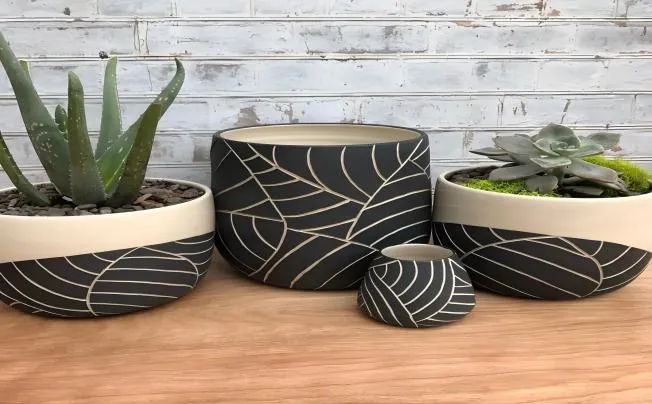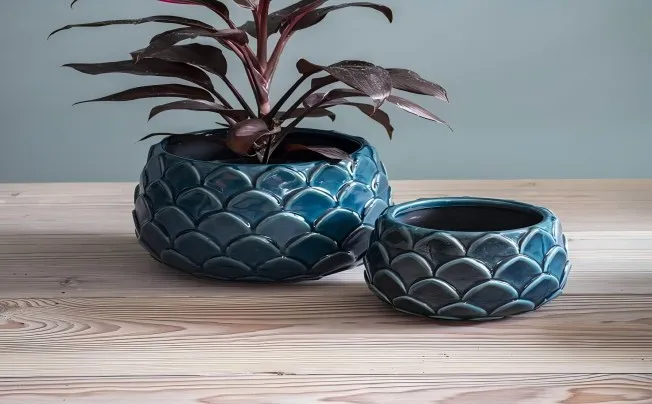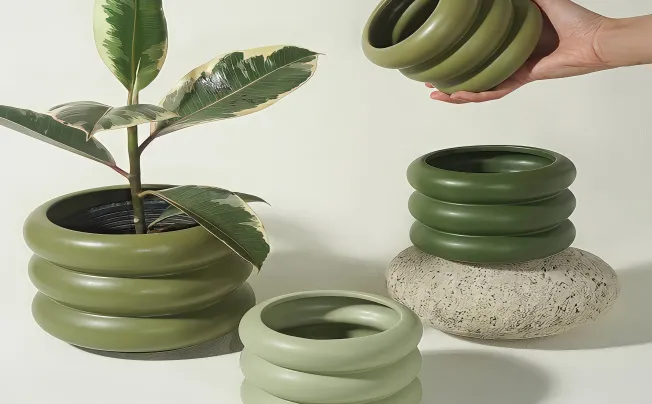Do Plants Grow Better In Plastic Or Ceramic Pots?
Plastic flower pots VS ceramic flower pots: Which is the best partner for plants?
Plastic flower pots: cost-effective choice
Large-scale planting or regular flower pot replacement is stress-free because common plastic flower pots are frequently merely a quarter of the cost of other materials, or even less. The cost benefit of plastic flower pots is particularly noticeable during certain sales, and occasionally they may even be bought in quantity for incredibly low costs, which is highly alluring to people who are interested in propagating plants or creating expansive balcony gardens.
Because plastic flower pots are lightweight, they are very easy to handle and carry. It's easy to move from indoor to outdoor settings and looks great on a tall flower stand. Additionally, plastic flower pots are quite resilient to falling, and even if they are knocked over by accident, they won't be readily broken. This is a significant benefit for households with kids or pets who are vulnerable to unintentional collisions.
Plastic flower pots can be moulded into a variety of distinctive shapes. From vibrant and exciting bright colours to fresh and delicate pastel colours, there is a wide range of colour options. To add some colour to your home, you may simply select plastic flower pots that complement various plant species, seasons, and interior design trends.
Plastic flower pots do, however, offer a few clear drawbacks.
Its air permeability is low. During growth, plant roots must be able to breathe, and unlike clay flower pots, plastic flower pots do not permit air to flow freely. As a result, the water in the pot's soil slowly evaporates, making it simple for water to build up. Long-term water buildup in the roots can lead to a shortage of oxygen, which can lead to rot and interfere with the plants' ability to grow healthily.
Another issue with plastic flower pots is their ageing. Long-term exposure to the sun will cause the plastic to progressively become brittle, develop surface fractures, and eventually shatter. The combined impacts of high temperatures and intense sunlight will hasten the ageing process of plastic flower pots, particularly during the sweltering summer months. Because of the low temperatures and the potential for harm from even a small touch, plastic flower pots can also become unstable during the cold winter months. In addition to degrading the look, ageing plastic flower pots may also prevent plants from growing properly and require replacement sooner rather than later.

Ceramic flower pots: both beautiful and textured
Ceramic flower pots can be seamlessly incorporated into a variety of décor styles, including European classical, modern simplicity, traditional Chinese, and others, giving the home a distinctively creative feel. When combined with rare flower kinds, ceramic flower pots with distinctive designs and superb craftsmanship are frequently seen in high-end home décor, instantly elevating the overall aesthetic of the room.
Flower pots made of ceramic have a complex manufacturing procedure. High-temperature burning produces a hard, long-lasting texture. A high-quality ceramic flower pot doesn't need to be replaced very often for years or even longer. In addition to being aesthetically pleasing, the glaze on its surface provides anti-corrosion and waterproof qualities that may effectively shield the flower pot from environmental damage. Furthermore, the water retention and air permeability of ceramic flower pots are comparatively balanced. When compared to plastic flower pots, the air permeability is not as good as that of clay flower pots; yet, it still permits some air circulation, allowing the soil to remain somewhat open. Ceramic flower pots are excellent at holding onto moisture in the soil and lowering the need for frequent watering. It is a fantastic option for certain plants that prefer a humid atmosphere.
Ceramic flower pots aren't flawless, though. Particularly for larger flower pots, which are particularly difficult to move, it is heavy. The weight of the ceramic flower pot can become an issue if you have to move it around a lot or if you put it in a high spot, as on the railing of a high-rise balcony. Additionally, ceramic flower pots are easily broken and brittle. In everyday use, the flower pot is prone to break if you bump into something hard or drop it while travelling. This could harm the plants in addition to detracting from the pot's beauty. Additionally, ceramic flower pots are typically expensive due to the cost of materials and the production process. Ordinary ceramic flower pots can cost many times as much as plastic ones, and certain ceramic flower pots with intricate designs and intricate craftsmanship can cost even more. This can put a strain on flower lovers with tight budgets.

Pot preferences of different plants
Depending on their growth habits and environmental conditions, different plants have different preferences for pot materials.
1. Because plastic pots retain water well, they can give plants like Monstera and Pothos a relatively moist soil environment, which is ideal for their healthy growth. Using plastic pots when growing Monstera indoors can reduce the frequency of watering and eliminate the worry that the plants will run out of water too quickly.
2. The majority of succulents are indigenous to arid regions and have very high drainage and soil permeability needs. Succulent roots can easily rot if they are left in a humid atmosphere for an extended period of time. Succulents may flourish in a dry and breathable environment because to the clay pots' high air permeability, which permits air to circulate freely through the soil and the rapid evaporation of excess water. To improve the airflow and strength of their roots, common succulents like bear's paw and cactus can be planted in clay pots.
3. Another plant with a high need for air permeability is the orchid. Their root systems are very unique, and they need enough oxygen to keep their bodies functioning normally. Orchids' requirements for drainage and air permeability can be satisfied by clay pots. Planting orchids in clay pots helps prevent root rot brought on by water buildup, giving the roots a healthy environment to grow and develop. This encourages the plant's general growth and produces more gorgeous blossoms.

Selected Blogs
-
What customization services are available for metalworking customization?
2024-12-12
-
What Is The Difference Between A Plant Container And A Raised Bed?
2024-04-23
-
Garden Screening & Fence Panels
2024-04-23
-
Gardening pot selection tips
2024-04-17
-
The function and collocation of horticultural fire pot
2024-04-17


